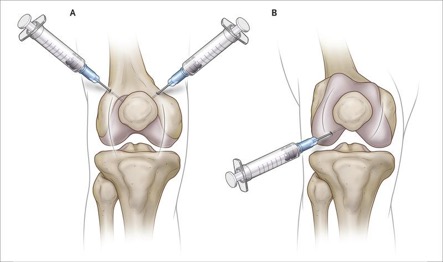Visco-supplementation treatment
A treatment for knee arthritis which is a temporary measure to delay eventual surgery.
 Osteoarthritis (OA), or degenerative arthritis, is the most common form of arthritis. While OA can affect almost any joint in the body, it occurs most frequently in the knees, fingers, hips and spine.
Osteoarthritis (OA), or degenerative arthritis, is the most common form of arthritis. While OA can affect almost any joint in the body, it occurs most frequently in the knees, fingers, hips and spine.
OA can affect people of all ages, but tends to occur most commonly in those aged 50 or older, and is often referred to as “wear and tear”. Earlier ligament or meniscal tears, and previous fractures can accelerate the rate of OA development.
What happens as OA progresses?
Usually, joints have a layer of firm, rubbery material called cartilage. This lines the ends of each bone, reducing friction and allowing the bones to glide over each other smoothly.
As OA occurs, the cartilage begins to break down, leading to joint pain and decreased range of motion. Things get worse over time as bits of bone begin breaking down, leading to the development of growths called bone spurs, or osteophytes.
Small fragments of bone or cartilage may also chip off and float around in the joint space, causing unwanted locking of the joint. In late stages of OA, the joint space is greatly reduced and bone rubs against bone, resulting in severe joint pain and stiffness.
What can we do to slow down OA?
OA cannot be cured as it is a chronic degenerative condition. However, we can delay its onset by implementing lifestyle changes like maintaining a healthy weight, continuing to be physically active, and performing muscle strengthening exercises to ease the burden on the knee joints. Patients can also consider joint support or braces, and walking aids.
The following treatments can also help with symptom management:
- Medications
- Oral/topical analgesics eg. nonsteroidal anti-inflammatory drugs (NSAIDs), paracetamol or opioids.
- Oral supplements that help to reduce inflammation, slow down cartilage degeneration and promote collagen formation.
- Physiotherapy
- Intra-articular corticosteroid injection
- Surgery
- In the late stages of OA, joints are severely damaged, and surgery may be indicated. Surgical options include arthroscopy, knee osteotomy, partial or total knee replacement.
Viscosupplementation as an OA treatment
Another treatment is a procedure known as viscosupplementation. This can be an option if knee pain and activity limitations still exist after all other non-surgical treatments have been attempted.
In viscosupplementation, a gel-like, naturally occurring lubricant called hyaluronic acid is injected into the knee joint. This substance is naturally found in the synovial fluid surrounding our joints. Since people with OA have a lower concentration of hyaluronic acid in their joints, adding it via viscosupplementation can help reduce pain and facilitate movement.
It is important to note that viscosupplementation is not a cure, but a temporary treatment measure to delay eventual surgery. It does not slow down the development of OA, or help to regenerate new cartilage. While many patients gain pain relief through this treatment, a significant proportion do not experience improvements from this treatment.
The viscosupplementation procedure
 Depending on the type of product used, three to five injections of hyaluronic acid are given, with each injection given one week apart.
Depending on the type of product used, three to five injections of hyaluronic acid are given, with each injection given one week apart.
During the procedure, if there is any swelling in the knee, your healthcare provider may first draw out the excess fluid from the joint before injecting hyaluronic acid. This is usually performed using a single injection site. For the first 48 hours after the injection, you should avoid prolonged standing, excessive walking, jogging or heavy lifting.
The procedure may not work effectively if the full series of injections is not completed.
Side effects and possible complications of viscosupplementation
Some people develop slight pain, warmth, and swelling in the joint immediately after the procedure. These symptoms usually don’t last long. Using an ice pack may help. Inform your healthcare provider if these symptoms persist or develop into severe warmth, redness, pain or high fever.
Complications of this procedure occur very rarely, and include allergic reaction, infection and bleeding.
Outcomes of viscosupplementation
As mentioned, some patients do not gain symptom relief despite viscosupplementation. For those who do respond to the treatment, improvements may take several weeks to become noticeable. This symptom relief may last for several months. If viscosupplementation is effective for you, it is possible to repeat the procedure after approximately six months.
Dr Edwin Ong is a resident doctor at DTAP Clinic.
(** PHOTO CREDIT: Pixabay/Wolfgang Claussen)

0 Comments